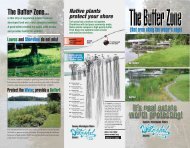Slope Stabilization Work Plan For Poplar River Management Board
Slope Stabilization Work Plan For Poplar River Management Board
Slope Stabilization Work Plan For Poplar River Management Board
You also want an ePaper? Increase the reach of your titles
YUMPU automatically turns print PDFs into web optimized ePapers that Google loves.
<strong>Slope</strong> <strong>Stabilization</strong> <strong>Work</strong> <strong>Plan</strong><br />
North American Wetland Engineering, LLC.<br />
January 18, 2007 4444 Centerville Rd, Suite 140<br />
<strong>Poplar</strong> <strong>River</strong> <strong>Management</strong> <strong>Board</strong> White Bear Lake, MN 55127<br />
Phone: 651-255-5050<br />
Fax: 651-255-5060<br />
Section 4 - Existing Site Conditions<br />
4.1 Megaslump Watershed Investigation<br />
On September 26, 2006, North American Wetland Engineering made a site visit to assess the<br />
characteristics of the megaslump area. The purpose of the site visit was to inspect the face of the<br />
slump and gather information relating to potential causes of the slump. At the time of the<br />
investigation, the river was at a very low stage and the weather was overcast and drizzling.<br />
Photographs were taken of the entire slump area and are included in Appendix A.<br />
On the face of the slump, rill erosion was prevalent as were a number of large gullies. The<br />
effluent pipe from the Caribou Highlands wastewater treatment lagoons was located at the top of<br />
the largest gully,. There was water leaking out of this pipe into the gully and the soil was<br />
saturated at this location. There were grasses growing on the face of the slump in some areas<br />
and certain areas had well established tree growth. At the top of the slump, undercutting of the<br />
bank was taking place and roots from trees were exposed.<br />
There were three main portions of the slump that were identified. The first was the upstream<br />
third of the slump. This area had numerous gullies and the most prevalent rill erosion. There<br />
were well established trees at the base of the slump adjacent to the river. The second area was<br />
the middle third of the slump. This area had exposed soils throughout the entire height of the<br />
slump. This area also had the steepest slope from the river to the top of the slump. The<br />
downstream third of the slump had exposed soils on the top portion of the slump and well<br />
established tree growth on the bottom two thirds of the slump. The slope in this area was not as<br />
steep as the middle third of the slump area. It was determined that three different approaches to<br />
stabilize the slope may be necessary in these different areas.<br />
On November 30, 2006, North American Wetland Engineering investigated potential watershed<br />
issues within the megaslump area. Specifically, the investigation was to determine possible<br />
surface water runoff contributions to the area on the upland portion of the megaslump. The<br />
<strong>Poplar</strong> <strong>River</strong> itself was also re-examined to identify peak flow levels, existing armoring,<br />
potential physiographic disruptions, and potential diversion routes.<br />
<strong>River</strong> investigation – The <strong>Poplar</strong> <strong>River</strong> channel takes two sharp bends near the megaslump. One<br />
upstream near where Lutsen Mountains removes river water for snow making and one that<br />
effectively defines the boundaries of the megaslump. The snow making withdrawal and storage<br />
is located just after a bend in the river upstream from the megaslump. The surrounding land is<br />
only a few feet higher than the river.







